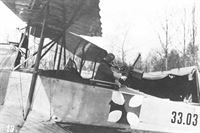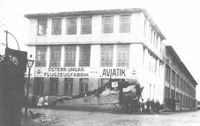
Описание
Страна: Австро-Венгрия
Год: 1915
А.Александров, Г.Петров Крылатые пленники России
В начале 1915 г. специалисты венской фирмы "Авиатик" Карл Иллнер и Альфред Гасснер (Karl Illner, Alfred Gassner) сконструировали модель Б.III - оснащенный 160-сильным мотором "Даймлер" биплан классической формы с вполне заурядными характеристиками: размах 15,30 м, длина 9,40 м, высота 3,47 м, площадь крыльев 42,2 кв. м, вес пустого 920 кг, взлетный вес 1357 кг, максимальная скорость 122 км/ч, скороподъемность 1000 м за 8 минут 5 секунд.
Осенью 1915 г. и весной 1916 г. компания получила два заказа в общей сложности на 52 аппарата 33-й серии, которым отводились номера с 33.01 по 33.52. Внедрение типа в серийное производство проходило не без проблем, но с февраля 1916 г. "Б-третьи" все же начали поступать в воевавшие на Восточном фронте 5, 10, 14, 20, 22 и 27-й австро-венгерские авиаотряды. Эксплуатация в полевых условиях выявила два основных недостатка конструкции - ее перегруженность и слабую энерговооруженность, и летом 1916 г. модель перевели в разряд тренировочных - благо ее просторная кабина облегчала взаимодействие ученика и инструктора. Тридцать семь "Авиатиков Б.III" передали в школьные подразделения, где часть из них продолжала службу даже в 1918 г. Некоторые не дождались спокойной жизни, как, например, изображенный на снимке аэроплан с номером 33.02, попавший в русский плен при неизвестных обстоятельствах. В кабине на турели находится германский пулемет "Бергманн" (Maschinengewehr 15nA - Bergmann) образца 1915 г. Его характеристики были следующими: калибр 7,92 мм, вес 9,80 кг, скорострельность 500 выстрелов в минуту. Питание осуществлялось с помощью ленты на 200 патронов, хранившейся в патронной коробке.
Описание:
- А.Александров, Г.Петров Крылатые пленники России
- P.Grosz, G.Haddow, P.Shiemer Austro-Hungarian Army Aircraft of World War One (Flying Machines)
- E.Hauke, W.Schroeder, B.Totschinger Die Flugzeuge der k.u.k. Luftfahrtruppe und Seeflieger 1914-1918
Фотографии
-
P.Grosz, G.Haddow, P.Shiemer - Austro-Hungarian Army Aircraft of World War One /Flying Machines/
Photographs of aircraft armed with the Bergmann LMG 15nA machine gun are rare. One of the few is the Aviatik B.III 33.03, assigned to Flik 20 on the Eastern Front in February 1916. Sharing a large cockpit with the pilot, the observer is checking a German Bergmann LMG 15nA machine gun.
-
E.Hauke, W.Schroeder, B.Totschinger - Die Flugzeuge der k.u.k. Luftfahrtruppe und Seeflieger 1914-1918
Aviatik B.III 33.18 in Aspern, Flugzeug hatte sehr schleehte Flugeigenschaften, wurde von den Besatzungen abfällig als "Schaukelstuhl" bezeichnet
Aviatik B.III 33.18 в Асперне, самолет имел очень плохие летные характеристики, пренебрежительно именовался экипажами «креслом-качалкой». -
P.Grosz, G.Haddow, P.Shiemer - Austro-Hungarian Army Aircraft of World War One /Flying Machines/
Assigned to Schulkompagnie 1 in December 1916, the Aviatik B.III 33.18 served as an advanced trainer until it was written-off in May 1917. The generator drive belt connecting the propeller hub to the wireless generator is missing.
-
P.Grosz, G.Haddow, P.Shiemer - Austro-Hungarian Army Aircraft of World War One /Flying Machines/
Aviatik B.III 33.18 during acceptance testing at Aspern in March 1916. Power was supplied by a 160 hp Daimler engine.
-
P.Grosz, G.Haddow, P.Shiemer - Austro-Hungarian Army Aircraft of World War One /Flying Machines/
Posed ready for takeoff, this Aviatik B.III 33.03 was accepted in June 1916 and went on to serve with Flik 27 on the Russian Front.
-
E.Hauke, W.Schroeder, B.Totschinger - Die Flugzeuge der k.u.k. Luftfahrtruppe und Seeflieger 1914-1918
Aviatik B.III 33.30 bei der Flik 27
-
P.Grosz, G.Haddow, P.Shiemer - Austro-Hungarian Army Aircraft of World War One /Flying Machines/
Personnel of the Aviatik factory in Vienna celebrating the completion of their 100th aircraft, an Aviatik B.III series 33 biplane, in mid-1916.
-
P.Grosz, G.Haddow, P.Shiemer - Austro-Hungarian Army Aircraft of World War One /Flying Machines/
The Aviatik B.III was dubbed “the rocking chair" and Leutnant von Festraets, ensconced in the large common cockpit, shows why. For training purposes the instructor and student could both work the controls.
-
P.Grosz, G.Haddow, P.Shiemer - Austro-Hungarian Army Aircraft of World War One /Flying Machines/
Aviatik B.III Series 33










